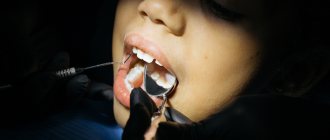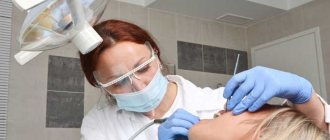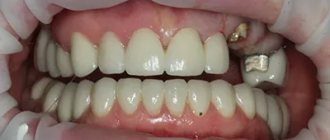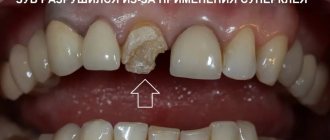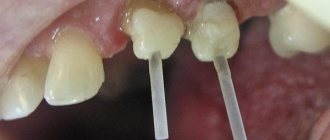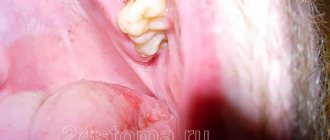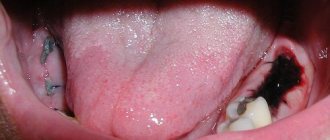Tooth root removal is one of the most labor-intensive and complex procedures in modern dental practice. The indication for its implementation is the preservation of the root part of the tooth in the gum, subject to complete destruction of the crown (for example, in severe forms of caries, as a result of injury or illiterate dental treatment). Untimely operations to extract such units is a factor contributing to the development of a whole range of diseases (periodontitis, periostitis, etc.). That is why “problem” roots must be removed as soon as possible.
When is tooth root removal required?
The decision to remove a tooth root can only be made by the attending physician, taking into account the patient’s indications in a particular case. If the affected tooth root can be treated, then the necessary procedures can be carried out and used as a support for the crown. However, there are a number of scenarios that require mandatory root removal.
- If, as a result of advanced periodontitis, the tooth has become mobile.
- When the root of a tooth is broken or cracked and hurts, and the gums and cheek are swollen.
- If the tooth is destroyed to the level of gum tissue and cannot be restored.
- When a wisdom tooth interferes with the development and alignment of other teeth or causes constant pain.
- If there is a cyst that cannot be removed without removing the root.
- If the wall of the tooth breaks off, and the resulting fragment extends under the gum.
- When part of the root remains after tooth extraction.
Separately, it is worth noting the removal of the root of baby teeth - usually dentists prefer to let the tooth fall out on its own, but sometimes intervention is necessary, for example, when more than half of the tooth is damaged by caries; when the tooth is very loose; if a tooth is broken and its remainder injures the gums; when the root is affected by caries and there is a risk of spreading to the adjacent tooth; with severe inflammation in the root area, which cannot be eliminated without resorting to removal.
CONCLUSIONS:
As you can see from the examples provided, I, orthopedic dentist Sergei Samsakov, an expert in the field of digital modeling and restoration of teeth using Cerec, manage to restore a beautiful smile even in almost the most hopeless cases. If you have similar problems, do not hesitate, contact us, and we will always find the optimal and, most importantly, beautiful solution to your situation.
And remember the simple truth: there are no hopeless situations!
Is it possible to leave it?
Some patients can walk for years with a tooth destroyed to the ground, not realizing that rotting roots are a breeding ground for infection and, at a minimum, provoke constant bad breath. Affected roots absorb bacteria and food particles like a sponge. Over time, plaque and stone form on the remnants of the root, causing the gum tissue to become inflamed.
Often patients ignore the problem, hoping that root removal without a tooth will not be necessary, since it will come out on its own. This is a big misconception - in rare cases, a fragment of a tooth can actually come out, but not its root. Delay will only lead to the root becoming overgrown, which is why the gum will have to be cut to remove the root of the destroyed tooth.
The body's constant fight against infection in the root area means that the human immune system directs part of its resources to solve the problem. Ultimately, this will provoke the development of infection and inflammation, and for patients this turns out to be a surprise every time. In some cases, if the rotten tooth root is not removed in time, infection in the upper jaw can spread to the maxillary sinuses, and in the lower jaw it can lead to a fracture or osteomyelitis.
Signs that a root remains after tooth extraction
If the root remains in the gum after a tooth extraction was performed poorly, then the problem is difficult to identify without diagnosis. But if a lot of time has passed since the extraction, and you feel twitching or pulsation in the area of the missing tooth, acute pain due to mechanical impact, observe redness or bleeding from the gums, or increased temperature, this may very likely indicate the presence of a tooth root remnant. If a root remains in the gum after tooth extraction, the consequences will not take long to arrive. Therefore, as soon as you have such a suspicion, contact a specialist as soon as possible.
Indications for surgery
Today, dentists prefer tooth-preserving operations. Therefore, even if there is only one root left, they first study whether it can be used as a basis for future prosthetics. However, in medical practice there are often situations when the removal of a decayed tooth must be carried out without fail.
This is possible if:
the tooth base has become very loose due to advanced periodontitis;- fracture diagnosed;
- a cyst has been discovered that cannot be removed in isolation;
- a fragment of the crown that extends deep under the gum has broken off;
- a part remained after the unit was carelessly removed.
Milk units should ideally fall out on their own. They are pulled out when the coronal part is completely damaged by caries, loosened or fractured, or a carious process that has spread under the gum.
Stages of removing the root of a decayed tooth
The operation of removing the root of a tooth is a procedure even more labor-intensive than removing a whole tooth. Preparation standardly includes a visual examination of the oral cavity, diagnosis using special equipment and sanitation. The test results allow you to draw up a treatment plan in accordance with medical indications, age, health status and other characteristics of the body, as well as select the optimal instruments and anesthetics for the procedure.
How is root removal done without a tooth?
- The doctor injects the patient with a local anesthetic, selected in such a way as to exclude allergies and other body reactions.
- After 10 minutes (when the anesthetic has taken effect), the circular ligament is separated from the neck of the tooth. If there is no inflammation of the gum tissue, then they are also moved away from the edge of the alveoli. If the root is deeply recessed into the hole or has become overgrown, then you will need to cut the gum and drill out part of the bone tissue to access the root.
- Next, the tooth root is removed using forceps or a dental elevator. If the tooth has a multi-root system, it will first be separated using a drill or ultrasound, and then removed in parts. This is called complex removal.
- After removing the tooth root, the hole is treated with a special solution. If the gum is cut, then after the operation sutures are placed and the operated area is treated with drugs that will help speed up healing.
Note!
Removing the root of the upper teeth is somewhat different from removing the roots of the lower jaw tooth. The roots of the lower jaw are most often removed using elevators: the instrument is placed between the gum bone tissue and the root and the handle is rotated. When removing the roots of the teeth of the upper jaw, bayonet-shaped forceps are often used - medium for canines, incisors and premolars and wide for molars. Using a tool, the circular ligament of the tooth is first peeled off, then single roots are twisted, and those connected to each other are dislocated.
If there are root fragments left in the hole
If the wound edges were tightened with catgut, the patient’s treatment can be considered complete. If a non-absorbable material was used, the patient will have to return to the dentist to have the sutures removed after a week. During this time, it is necessary to monitor the condition of the gums, your own sensations and notify the doctor if:
- the operated areas constantly hurt;
- throbbing pain is felt.
This means that small fragments of tooth tissue, which may have gone unnoticed during extraction, rot in the hole. The doctor must prescribe a repeat X-ray for the patient, check the quality of the operation and find out the cause of the ailment. Inaction is fraught with the development of alveolitis (inflammation of the socket), osteomyelitis, phlegmon and other serious diseases.
Features of wisdom tooth root removal
When removing the root of wisdom teeth, the complexity of the procedure is added by the fact that figure eights often grow at an angle; accordingly, their roots are located perpendicular to the roots of neighboring teeth. Therefore, the procedure is carried out using x-rays, especially if the crown is destroyed. The procedure should be carried out by an experienced specialist to eliminate the possibility that a root remains after the removal of a wisdom tooth.
How to determine if a root is healthy
How to understand whether caries has affected the root of the tooth, whether the dentin of the tooth root is intact or whether there are defects? In order to have an objective picture of the process, it is necessary to perform an x-ray of the tooth root and a computed tomogram. A CT scan will determine the true condition of the root and show:
- The presence of inflammatory processes.
- It will determine whether there are neoplasms and what size they are (cyst or granuloma).
- The location of the roots in relation to the neighboring ones, the maxillary sinus.
This is the only way to see whether it will be possible to cure the tooth root using a tab.
Tooth root removal under anesthesia
As a rule, root removal is performed under local anesthesia, but if the patient has a complex tooth root extraction, or if he has intolerance to local anesthetics or dentophobia, the specialist performs the procedure for tooth root removal under general anesthesia. This allows all manipulations to be carried out with complete comfort for the patient - while he is sleeping. However, this method has a number of serious contraindications: its use can have a negative effect on the heart, kidneys and brain. In addition, patients often experience nausea, headache, and confusion as they emerge from anesthesia. Therefore, they try to resort to anesthesia only as a last resort, giving preference to sedation. This is a modern type of general anesthesia, which involves deep relaxation, during which the patient remains conscious and can contact the doctor, but with this type of tooth root removal, pain and stress are completely eliminated.
Benefits of Cerec Restoration
The innovation has clear advantages compared to traditional prosthetics:
- The process does not take a week or several days, but only 1.5 hours
per tooth maximum. - Accuracy
. The computer minimizes errors and eliminates errors. - Biocompatibility
. Fabrics do not reject materials.
An inlay in the tooth root is created quickly, then the crown is modeled. The price is fully justified by the reliability, long service life of the structures and their aesthetics.
There is a striking difference between the smiles of patients when they only had the root of the tooth left, and the photo after treatment with Cerec dentures.
Tooth root amputation as a treatment
In some cases, complete tooth root removal can be replaced by a tooth-saving operation called amputation. This is the removal of part of the tooth root, allowing you to save a healthy fragment. During the procedure, the affected area is cut off and the cavity is filled with osteoplastic mass.
Tooth-preserving extraction operations also include hemisection, in which part of the root system is removed along with the adjacent crown area. These two methods allow you to preserve the physiological function of the tooth and use it to install a bridge. It is important to understand: no doctor can guarantee that such a tooth will last a long time, since partial loss of the root will lead to a violation of the stability of the tooth. Therefore, if you notice that for a long time after root removal the tooth hurts or causes you other discomfort, you should definitely contact your doctor.
Features of postoperative care
There are a number of recommendations that can significantly speed up the healing process of a wound formed during surgery and avoid the development of complications. In particular, dentists advise:
- during the first 24 hours, avoid too warm baths, do not go to the baths, refrain from any, even minor, physical activity, apply ice to the cheek on the side of the removed root every half hour;
- give up alcohol and smoking, too hot and spicy food for 2 days;
- take analgesics if pain occurs;
- for several days, try not to chew food on the operated side, give up the habit of biting your lips or sucking in your cheeks (this creates a vacuum in the mouth that can displace a blood clot formed on the wound);
- undergo a full course of treatment with antibacterial agents if prescribed by a dentist.
If signs indicating the development of complications appear, it is necessary to abandon attempts at self-medication and seek help from a doctor at the 24-hour A.Dent dentistry as soon as possible.
How much does tooth root removal cost?
As a rule, the price for tooth root removal is determined based on the complexity of the case, and can vary greatly depending on the segment of the clinic, the qualifications of the doctor and other factors. Standard removal starts at an average of 3,000 rubles, complex removal will cost at least 5,000 rubles. Your attending physician will help you make more accurate calculations based on the diagnostic results. In any case, the sooner you go to the clinic, the less likely it is that complications will develop, especially since modern dental offices have all the capabilities to carry out the procedure efficiently and minimize the unpleasant consequences of tooth root removal.
How to remove complex teeth: basic techniques
In dentistry, various methods are used to eliminate a complicated tooth, the essence of which depends on the instruments chosen for manipulation:
- removal using forceps. Compared to
in other ways, this is considered the most gentle. This technique is used in cases where the integrity of the crown is preserved. The surgeon grabs the crown with forceps and loosens it in a circular motion until the tooth root ruptures from the alveolus, after which he pulls it out; - elevator extraction. If it is located outside the dentition, it is impossible to pull it out with ordinary forceps, then this technique is used. The instrument is inserted into the periodontal fissure and rotated, as a result of which the ligaments are torn. The tooth is not pulled out of the hole, but squeezed out;
- removal with a drill. This method is used to pull out teeth with multiple roots. First, the roots are separated using a drill and then each piece is removed separately. If a resorcinol-formalin filling is installed on a tooth, then a drill is also used to pull it out.
Which method is the best? Each has certain characteristics and is selected based on the condition of the tooth, the number and depth of its roots.
Why do teeth rot?
Unfortunately, almost any patient can experience tooth decay. Causes of pathology:
- mechanical or chemical injury to the enamel or crown, leading to rapid destruction of dentin and pulp;
- poor oral hygiene - lack of regular brushing, incorrect selection of toothbrushes and toothpastes;
- bad habits - alcohol abuse, frequent smoking, drugs;
- poor ecology - for this reason, rotten molars are increasingly diagnosed among residents of megacities;
- unbalanced diet - a small amount of vegetables and fruits in the diet, excessive consumption of sweet and flour products;
- lack of vitamins and minerals - primarily a lack of fluoride and calcium;
- heredity - genetic predisposition to the rapid destruction of enamel and dentin;
- untreated dental diseases - advanced caries, pulpitis, gum and periodontal diseases;
- general decline in immunity - teeth often rot during serious chronic diseases of internal organs and systems, during pregnancy, and during periods of active growth in adolescents.
Relieve pain before going to the doctor
For any form of periodontitis, it is necessary to make an appointment with a doctor, but often the aching tooth “does not want” to wait for the appointed time and hurts unbearably. Taking a pain reliever will help relieve the condition. For toothache, experts advise taking medications that are most optimal for such cases. The pill will not cure, but it will relieve the pain. This does not mean that you can postpone a visit to the doctor - after the pill wears off, the pain will return, so a trip to the dentist should not be postponed or put off “for later”.
Bridges
The good old classic that dentists offer when they see that a root is missing. Bridges do not need to be removed from your mouth every day to be cleaned, unlike removable dentures, they will last 10-12 years with proper care and are much better at restoring chewing function. Modern materials are quite effective at restoring a beautiful appearance to a smile. The price and production time of such a prosthesis is higher than that of a removable prosthesis, but lower than that of an implant.
What are the disadvantages of this technique?
- With classic prosthetics relying on your own teeth, due to the uneven distribution of the load during chewing, the supporting teeth under the bridge gradually begin to collapse.
- Bone atrophy also does not stop.
- The denture requires special cleaning products - pipe cleaners, brushes, etc., otherwise food debris and plaque will accumulate under it.
- The implant-based method is not always possible - if one tooth or two in a row is lost, the doctor will not remove adjacent healthy teeth in order to put implants in their place.
What to do if a tooth is rotten
Rotten teeth - what to do? The first step is to make an appointment with a dentist and get ready for long-term treatment:
- Complete diagnostics of the oral cavity. A comprehensive X-ray examination will indicate changes in dental tissues, even if this is not visible during a routine examination.
- Identification of the main rotten areas. The doctor will determine the number of affected teeth and the stage of decay for each unit.
- Coordination of the treatment plan. Dental protocols are aimed at preserving each dental unit, so an experienced dental therapist will guide the patient towards treatment and filling cavities. If the decay process has gone very far and the root is affected, then the dental unit will have to be removed followed by prosthetics or implantation.
- Carrying out treatment. A rotten tooth usually indicates pulpitis, so the patient will have the dental nerve removed, the cavities cleared of pus, and the crown restored with high-quality composite materials.
- Professional hygiene. This is a mandatory stage in the fight against rotten teeth, so the patient will be referred for the removal of soft plaque and tartar.
- Identification of the causative agent of the pathological process. The doctor will make a smear for analysis, and after laboratory testing, will select therapy for the patient’s quick recovery.
Dental treatment of rotting units is always comprehensive, aimed at physical restoration and elimination of the causes of decay.
Rotten teeth: consequences for the body
A rotten black tooth is a direct path to the dentist. The doctor will make a diagnosis and provide treatment. But what happens if you don’t remove a rotten tooth? In cases where the tooth has rotted down to the gum, the consequences will affect the patient’s entire body:
- constant fatigue, apathy, frequent colds and ARVI - due to general intoxication due to infection and decreased immunity;
- deterioration of heart function - development of the disease endocarditis, inflammation of the inner lining of the heart;
- problems with the gastrointestinal tract - loss of appetite, gastritis, ulcers, dysbacteriosis;
- damage to the trigeminal nerve - chronic migraines, memory impairment, Alzheimer's disease;
- disruption of the musculoskeletal system - development of arthrosis, polyarthritis;
- problems with appearance - hair loss, deterioration of skin condition;
- decreased hearing quality.
A serious consideration of the question of what rotten teeth affects demonstrates the interdependence of all organs and parts of the human body. Deterioration of the oral cavity is a path to heart attack, thrombosis, abscesses and other diseases.
Signs that after tooth extraction the root system remains in the gums
If medical manipulations were performed correctly, normally there should be no fragments of the dental unit in the socket. Due to unprofessionalism and mistakes of the dentist and for other reasons, after some time it may be discovered that there are pieces of hard tissue in the gums. What symptoms can you tell by:
- persistent pain and throbbing sensation for several weeks;
- swelling, redness of the mucous membranes;
- increased body temperature (intermittent or persistent fever);
- slow wound healing, bleeding.
If such symptoms appear, you should visit a dental clinic as soon as possible. The specialist will take a picture and give an opinion on whether complications have arisen after the extraction.
Why does crown destruction occur?
The most common cause of crown destruction is the development of carious lesions. Also, a damaged crown can result from mechanical trauma. Below are the most common factors that lead to this problem:
- advanced caries: the most common cause. Caries begins with a small spot on the enamel, but gradually the inflammatory process goes deeper, first affecting the entire coronal part, and then its nerve,
- absence of a nerve: they are more fragile than living ones, especially if the coronal part has been restored with a filling or inlay.
- excessive load: there are often situations when a tooth breaks right at the root due to the fact that while eating a hard piece was caught - a stone, a bone. True, more fragile teeth are susceptible to this, for example, if the human body lacks certain vitamins,
- the presence of chips and cracks that were not treated: in such situations, the tooth will sooner or later break under load,
- the filling is too large and worn out: over time, composites wear out - they wear off, and the tightness of the seal to the tissue changes. The crown often breaks when there is a very large filling and at the same time thin walls of the tooth itself,
- a previously restored tooth: for example, built on a pin using composite materials.
